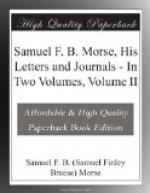“I have scarcely entered upon the business of the Telegraph, but have examined (tell Dr. Gale) the specification of Wheatstone at the Patent Office, and except the alarum part, he has nothing which interferes with mine. His invention is ingenious and beautiful, but very complicated, and he must use twelve wires where I use but four. I have also seen a telegraph exhibiting at Exeter Hall invented by Davy, something like Wheatstone’s but still complicated. I find mine is yet the simplest and hope to accomplish something, but always keep myself prepared for disappointment.”
At a later date he recounted the following pretty incident, showing the kindly character of the young queen, which may not be generally known:—
“I was in London in 1838, and was present with my excellent friend, the late Charles R. Leslie, R.A., at the imposing ceremonies of the coronation of the queen in Westminster Abbey. He then related to me the following incident which, I think, may truly be said to have been the first act of Her Majesty’s reign.
“When her predecessor, William IV, died, a messenger was immediately dispatched by his queen (then become by his death queen dowager) to Victoria, apprising her of the event. She immediately called for paper and indited a letter of condolence to the widow. Folding it, she directed it ‘To the Queen of England.’ Her maid of honor in attendance, noting the inscription, said: ‘Your Majesty, you are Queen of England.’ ‘Yes,’ she replied, ’but the widowed queen is not to be reminded of that fact first by me.’”
Writing to his daughter from Havre, on July 26, 1838, while on his way to Paris, after telling her of the unjust decision of the Attorney-General, he adds:—
“Professor Wheatstone and Mr. Davy were my opponents. They have each very ingenious inventions of their own, particularly the former, who is a man of genius and one with whom I was personally much pleased. He has invented his, I believe, without knowing that I was engaged in an invention to produce a similar result; for, although he dates back into 1832, yet, as no publication of our thoughts was made by either, we are evidently independent of each other. My time has not been lost, however, for I have ascertained with certainty that the Telegraph of a single circuit and a recording apparatus is mine....
“I found also that both Mr. Wheatstone and Mr. Davy were endeavoring to simplify theirs by adding a recording apparatus and reducing theirs to a single circuit. The latter showed to the Attorney-General a drawing, which I obtained sight of, of a method by which he proposed a bungling imitation of my first characters, those that were printed in our journals, and one, however plausible on paper, and sufficiently so to deceive the Attorney-General, was perfectly impracticable. Partiality, from national or other motives, aside from the justice of the case, I am persuaded, influenced the decision against me.




